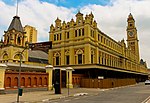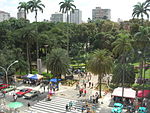Sala São Paulo

The Júlio Prestes Cultural Center, which is located in the Júlio Prestes Train Station in the old north central section of the city of São Paulo, Brazil, was inaugurated on July 9, 1999. The building has been restored and renovated by the São Paulo State Government, as part of the downtown revitalization in that city. It houses the Sala São Paulo, which has a capacity of 1498 seats and is the home of the São Paulo State Symphonic Orchestra (OSESP). It is a venue for symphonic and chamber presentations. Renovation began in November 1997, but the first steps were taken in 1995. Governor Mario Covas visualized the Julio Prestes space as ideal for symphonic presentations and because OSESP did not have a permanent home.
Excerpt from the Wikipedia article Sala São Paulo (License: CC BY-SA 3.0, Authors, Images).Sala São Paulo
Praça Júlio Prestes, São Paulo Campos Elísios (Santa Cecília)
Geographical coordinates (GPS) Address Phone number Website External links Nearby Places Show on map
Geographical coordinates (GPS)
| Latitude | Longitude |
|---|---|
| N -23.534166666667 ° | E -46.639722222222 ° |
Address
Sala São Paulo
Praça Júlio Prestes 16
01218-020 São Paulo, Campos Elísios (Santa Cecília)
São Paulo, Brazil
Open on Google Maps











